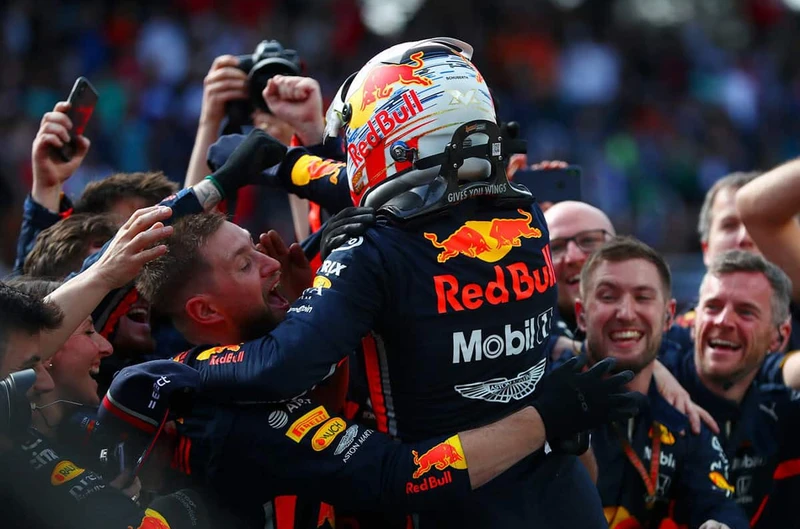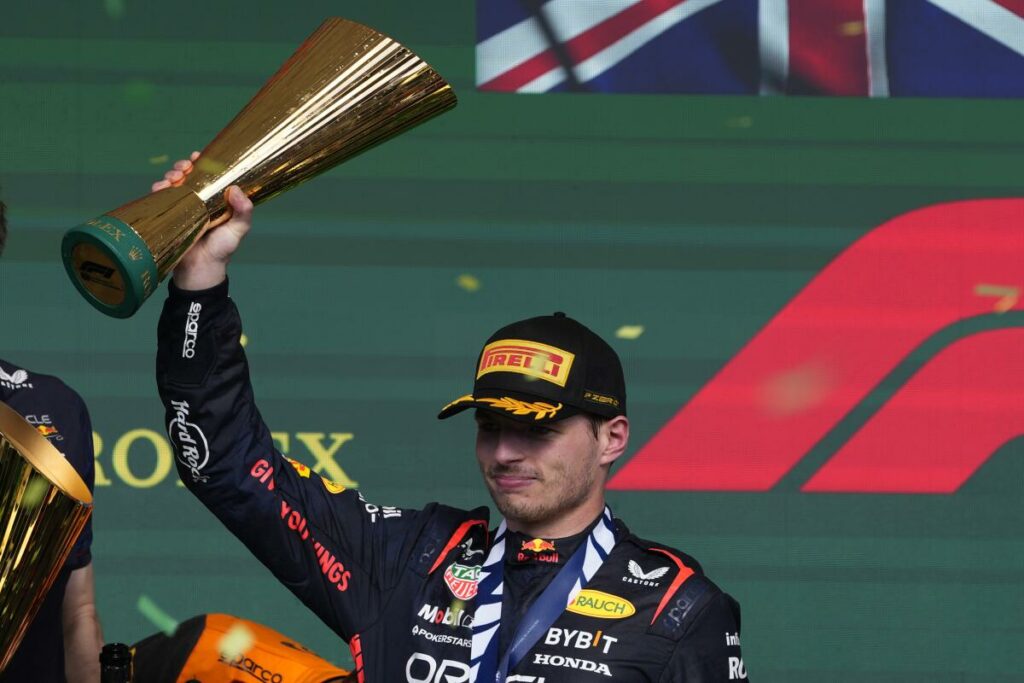Max Verstappen has once again proven his mettle in the high-octane world of Formula 1 (F1) by clinching victory at the 2024 Brazil Grand Prix in Sao Paulo, placing him firmly at the top of the standings. This remarkable achievement adds yet another chapter to his already illustrious career, showcasing his incredible talent, lightning-fast reactions, and strategic prowess on the track.
A Record-Breaking Victory for Max Verstappen
Verstappen’s win in Brazil was nothing short of spectacular. The race conditions were chaotic, with unpredictable weather throwing challenges at all drivers. However, Verstappen rose to the occasion, showcasing not only his vision and driving skills but also his ability to adapt quickly to the ever-changing circumstances. His impressive lap times during the race, particularly a blistering lap time of 1:10.2, set the tone for his domination throughout the event.
The Brazilian circuit is known for its tight turns and elevation changes, yet Verstappen navigated the course with an agility that left competitors trailing behind. His victory marks his 15th win of the 2024 season, reinforcing his status as the driver to beat in this year’s Formula One championship. His ability to maintain speed while making split-second decisions under pressure illustrates why he is a leading figure in F1 racing.
Driving Vision of Max Verstappen Against Unpredictable Race Conditions
The 2024 Brazil Grand Prix was characterized by unpredictable weather and slippery track conditions, adding an extra layer of complexity to the race. Heavy rain showers and changing visibility tested the limits of every driver. However, Verstappen’s exceptional skills shone through. As reported, he effectively used the challenging conditions to his advantage, executing overtakes and maintaining his lead with remarkable composure.
His strategic approach, combined with the high-speed reactions he displayed, were pivotal in navigating these treacherous conditions. Verstappen’s ability to read the track and anticipate the movements of his competitors allowed him to not only maintain his position but also extend his lead, securing a well-deserved victory. The intensity of the race had fans on the edge of their seats, especially those watching F1 live.
Having great vision is essential, especially in unpredictable weather conditions. Clear, sharp vision helps drivers quickly detect hazards and assess the distance and speed of other vehicles, which is crucial when visibility is reduced. In low light or glare situations, good vision enables quicker reactions to sudden changes, like a car shifting or braking suddenly. With optimal vision, drivers can better adapt to road challenges and make safer, more confident decisions, enhancing overall performance and safety.
Behind Max Verstappen’s Success: Vision and Coordination
Max Verstappen’s incredible performance in the Brazil Grand Prix can be attributed to more than just raw talent; it is also rooted in the science of vision and eye coordination. F1 drivers face unique challenges that require extraordinary levels of visual acuity and quick reflexes. The ability to process visual information at high speeds is crucial for making split-second decisions that can determine the outcome of a race.
Sports Vision therapy and eye training play essential roles in enhancing these capabilities. As outlined by experts, such training helps athletes improve depth perception, eye-hand coordination, and visual reaction times. For Verstappen, this training is vital; it allows him to maintain sharp focus and quick responses even in the most intense racing scenarios. His rigorous regimen includes specialized exercises designed to fine-tune his visual processing skills, ensuring that he is always at the top of his game.

The Science Behind Visual Coordination in F1 Racing
While Verstappen’s driving skills are undoubtedly impressive, it is essential to recognize the critical role that vision plays in his success. F1 drivers are faced with unique challenges that require extraordinary levels of visual acuity and quick reflexes. In fact, the ability to process visual information at high speeds is crucial for making split-second decisions that can determine the outcome of a race.
Depth Perception and Speed Perception
Depth perception is the ability to judge distances accurately, which is vital in racing. Drivers must assess how far they are from competitors, track boundaries, and apex points in corners. Verstappen’s exceptional depth perception allows him to navigate the Interlagos circuit with pinpoint accuracy, especially when overtaking other cars in tight spaces.
Speed perception is equally critical; drivers need to judge not only their speed but also the speed of surrounding vehicles. Verstappen’s acute awareness of his environment enables him to react swiftly to changes, making adjustments as necessary to maintain his lead or execute successful overtakes.
Visual Reaction Time
Visual reaction time—the speed at which the brain processes visual stimuli and translates them into action—is another essential component of Verstappen’s success. Research has shown that elite athletes, including F1 drivers, often have reaction times significantly faster than the average person. This rapid response ability allows Verstappen to respond to the dynamic situations on the track, such as sudden changes in traffic or obstacles.
During the Brazil Grand Prix, Verstappen’s visual reaction time was put to the test as he maneuvered through challenging conditions. His ability to react to the rain-soaked track and swiftly adjust his driving strategy was a testament to his extensive training and innate talent.
Sports Vision Therapy
To maintain and enhance these critical visual skills, Max Verstappen engages in rigorous vision training. This specialized training is designed to improve depth perception, eye-hand coordination, and visual reaction times. Just as athletes train their physical bodies, they must also train their visual systems to perform at their best.
Drills and Exercises
Vision training for F1 drivers often includes a range of drills and exercises. These may involve activities such as:
- Tracking exercises: Following moving objects with the eyes to enhance tracking skills.
- Depth perception drills: Judging distances through various tasks, helping drivers improve their ability to navigate tight spaces.
- Reaction time exercises: Using light or sound cues to train drivers to respond quickly and accurately to stimuli.
By incorporating these elements into their training, drivers like Max Verstappen can sharpen their visual acuity, ensuring they are always prepared for the demands of high-speed racing.
The Importance of Eye Exams for Athletes
To support his remarkable skills, Verstappen—and indeed all F1 drivers—prioritizes their eye health. Regular eye exams are essential for monitoring visual acuity and ensuring that any issues are addressed promptly. Just as Verstappen relies on his team for vehicle performance, he depends on eye care professionals to maintain optimal vision.
Annual eye exams can identify changes in vision that may require correction, allowing drivers to perform at their best. This proactive approach helps prevent vision-related issues that could hinder performance on the track. For an athlete like Verstappen, where every millisecond matters, having the best possible vision is critical.
The Future of F1 and Max Verstappen
Max Verstappen’s thrilling victory at the 2024 Brazil Grand Prix exemplifies not just his exceptional driving ability, but also the importance of vision coordination and eye health in the world of Formula One. As he continues to dominate the F1 circuit, fans eagerly anticipate what he will achieve next.
In a sport defined by speed and precision, the combination of Verstappen’s natural talent, rigorous vision training, and commitment to eye health positions him as a formidable champion in Formula One. As we look forward to future races, it’s clear that Max Verstappen is not only a winner today but is set to inspire future generations of racers.
For those who follow F1 live, witnessing Verstappen’s journey is an exhilarating experience. His story is a powerful reminder of the dedication, skill, and strategic thinking required to succeed at the highest level of motorsport. As he continues to push the limits, the excitement surrounding his performances only grows, making him a true icon in the world of F1 racing.
Eye Care Excellence like the Pros
If you’re looking to improve your vision like the pros, Optical Illusions: An Optometric Practice offers comprehensive eye exams, personalized vision care, and top-quality eyewear. Located in San Mateo, San Jose, San Ramon, and Juneau, Optical Illusions provides patients with the latest in eye care technology, including advanced diagnostics to detect and treat various eye conditions. Their team of board-certified optometrists ensures that each patient receives high-quality care to meet their individual needs.
Whether you need vision correction, are interested in contact lenses, or simply want to maintain good eye health, Optical Illusions is here to help you see your best. We prioritize your eye health and provide the best eye exams in our communities. Our experienced optometrists use state-of-the-art technology for so that our athletic patients have the best vision for peak performance. Contact our team to schedule your appointment at 1 of our 4 conveniently located offices using your VSP Vision insurance benefits today.




